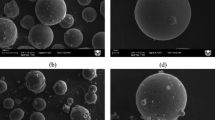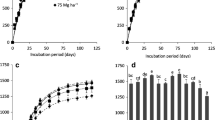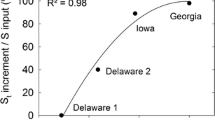Abstract
There is an increasing need to find a suitable means for disposal of coal combustion byproducts because of the increasing world-wide production of these byproducts. This need has prompted interest in the use of land disposal, but there are concerns that this use may degrade the quality of soil. To determine the influence of coal combustion byproducts on the transformation and fate of soil N and assess the potential impact of land disposal on soil quality, we studied the effects of two combustion byproducts (fly ash and bed ash) applied at rates of 22.5, 45, 90, and 180 Mg ha-1 on mineralization and volatile loss of N from soil. Studies comparing the influence of the byproducts on these processes showed that whereas fly ash had little influence on the fate of soil N, bed ash caused substantial mineralization of organic soil N and volatile loss of this N as NH3. Studies monitoring the pH of soils treated with bed ash showed that soil pH increased immediately after this treatment, with values reaching as high as 12.8. These studies indicated that such extreme alkaline conditions caused chemical degradation and volatile loss of as much as 10% of the organic N in soil, and they provide strong evidence that the improper disposal of bed ash on land can have a substantial negative impact on soil quality.
Similar content being viewed by others
References
Adriano DC, Page AL, Elseewi AA, Chang AC, Straugham I (1980) Utilization and disposal of fly ash and other coal residues in terrestrial ecosystems. A review. J Environ Qual 9: 333–344
Bremner JM (1949) Studies on soil organic matter Part I. The chemical nature of soil organic nitrogen. J Agric Sci 39: 183–193
Bremner JM, Harada T (1959) Release of ammonium and organic matter from soil by hydrofluoric acid and effect of hydrofluoric acid treatment on extraction of soil organic matter by neutral and alkaline reagents. J Agric Sci 52: 137–146
Bremner JM, Mulvaney CS (1982) Nitrogen — total. In: Page AL, Miller RH, Keeney DR (eds) Methods of soil analysis. Part 2. Am Soc Agron, Madison, Wis, Agronomy 9: 595–624
Bundy LG, Bremner JM (1972) A simple titrametric method for determination of inorganic carbon in soils. Soil Sci Soc Am Proc 36: 273–275
Carlson CL, Adriano DC (1993) Environmental impacts of coal combustion residues. J Environ Qual 22: 227–247
Cornfield AH (1960) Ammonia released on treating soils with N sodium hydroxide as a possible means of predicting the nitrogen-supplying power of soils. Nature (London) 187: 260–261
Gee GW, Bauder JW (1986) Particle-size analysis. In: Klute A (ed) Methods of soil analysis. Part 1. Am Soc Agron, Madison, Wis, Agronomy 9: 383–411
Haberern J (1992) Coming full-circle — the new emphasis on soil quality. Am J Alternative Agric 7: 3–4
Karlen DL, Eash NS, Unger PW (1992) Soil and crop management effects on soil quality indicators. Am J Alternative Agric 7: 5–10
Keeney DR (1982) Nitrogen — availability indices. In: Page AL, Miller RH, Keeney DR (eds) Methods of soil analysis. Part 2. Am Soc Agron, Madison, Wis, Agronomy 9: 711–733
Keeney DR, Bremner JM (1966) Comparison and evaluation of laboratory methods of obtaining an index of soil nitrogen availability. Agron J 58: 498–503
Keeney DR, Nelson DW (1982) Nitrogen — inorganic forms. In: Page AL, Miller RH, Keeney DR (eds) Methods of soil analysis. Part 2. Am Soc Agron, Madison, Wis, Agronomy 9: 643–698
Korcak RF (1985) Effect of coal combustion wastes used as lime substitutes in nutrition of apples in three soils. Plant and Soil 85: 437–441
Korcak RF (1993) High gypsum byproducts as soil amendments for horticultural crops. Hort Tech 3: 156–161
Marsh BH, Grove JH (1992a) Plant and soil composition as affected by an alternative lime source containing sulfate. Soil Sci Soc Am J 56: 1831–1836
Marsh BH, Grove JH (1992b) Surface and subsurface soil acidity: Soybean root response to sulfate-bearing spent lime. Soil Sci Soc Am J 56: 1837–1842
McCarty GW, Siddaramappa R, Wright RJ, Codling EE, Gao G (1994) Evaluation of coal combustion byproducts as soil liming materials: their influence on soil pH and enzyme activities. Biol Fertil Soils 17: 167–172
Nelson DW, Sommers LE (1982) Total carbon, organic carbon, and organic matter. In: Page AL, Miller RH, Keeney DR (eds) Methods of soil analysis. Part 2. Am Soc Agron, Madison, Wis, Agronomy 9: 539–579
Papendick RI, Parr JF (1992) Soil quality: The key to a sustainable agriculture. Am J Alternative Agric 7: 2–3
Parr JF, Papendick RI, Hornick SB, Meyer RE (1992) Soil quality: Atributes and relationships to alternative and sustainable agriculture. Am J Alternative Agric 7: 5–11
Phung HT, Lund LJ, Page AL (1978) Potential use of fly ash as a liming material. In: Adriano DC, Brisbin IL (eds) Environmental chemistry and cycling processes. Conference 760429. United States Department of Commerce, Springfield, Va, pp 504–514
Reganold JP, Palmer AS, Lockhart JC, Macgregor AN (1993) Soil quality and financial performance of biodynamic and conventional farms in New Zealand. Science 260: 344–349
Stanford G (1982) Assessment of soil nitrogen availability. In: Stevenson FJ, Bremner JM, Hauck RD, Keeney DR (eds) Nitrogen in agricultural soils. Am Soc Agron, Madison, Wis, Agronomy 22: 651–688
Stout WL, Hern JL, Korcak RF, Carlson CW (1988) Manual for applying fluidized bed combustion residue to agricultural lands. United States Department of Agriculture, Agricultural Research Service, ARS-74, Washington DC
Terman GL (1978) Solid wastes from coal-fired power plants: Use or disposal on agricultural lands. Bulletin Y-129 Tennessee Valley Authority, Muscle Shoals, Ala
Terman GL, Kilmer VJ, Hunt GM, Buchanan W (1978) Fluidized bed boiler waste as a source of nutrients and lime. J Environ Qual 7: 147–150
Thomas GW (1982) Exchangeable cations. In: Page AL, Miller RH, Keeney DR (eds) Methods of soil analysis. Part 2. Am Soc Agron, Madison, Wis, Agronomy 9: 159–165
Visser S, Parkinson D (1992) Soil biological criteria as indicators of soil quality. Am J Alternative Agric 7: 33–37
Yuan TL (1959) Determination of exchangeable hydrogen in soils by a titration method. Soil Sci 88: 164–167
Author information
Authors and Affiliations
Rights and permissions
About this article
Cite this article
Siddaramappa, R., McCarty, G.W., Wright, R.J. et al. Mineralization and volatile loss of nitrogen from soils treated with coal combustion byproducts. Biol Fert Soils 18, 279–284 (1994). https://doi.org/10.1007/BF00570629
Received:
Issue Date:
DOI: https://doi.org/10.1007/BF00570629




